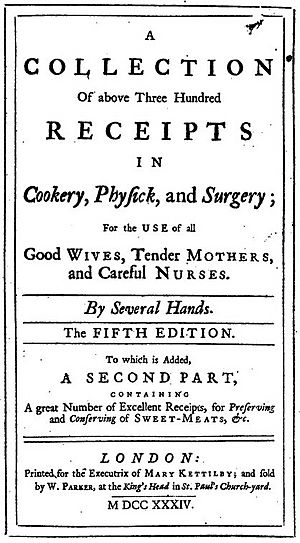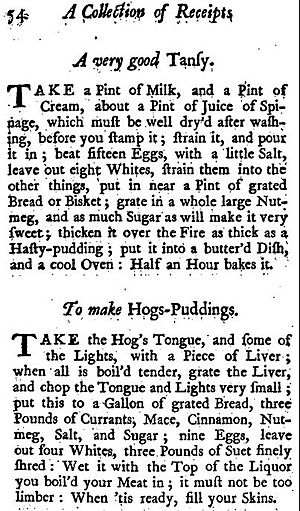A Collection of Above Three Hundred Receipts in Cookery, Physick and Surgery facts for kids
A Collection of Above Three Hundred Receipts in Cookery, Physick and Surgery is a very old English cookbook. It was written by Mary Kettilby and others, and first came out in 1714. This book has some of the earliest recipes for things like Christmas pudding, suet pudding, and even orange marmalade.
About the Book
Mary Kettilby made it clear who the book was for with its long title: A Collection of above Three Hundred Receipts in Cookery, Physick and Surgery; For the Use of all Good Wives, Tender Mothers, and Careful Nurses. This means it was mainly for women who managed their homes. The book was actually a team effort. The introduction says that "a Number of very Curious and Delicate House-wives Clubb'd to furnish out this Collection." This means many skilled homemakers worked together to create it.
What's Inside?
The book is split into different parts. Some parts are for food recipes, and others are for health remedies. For example, the 5th edition has these sections:
- A Collection of Receipts in Cookery, &c. (starts on page 9)
- A Collection of Receipts in Physick and Surgery (starts on page 99)
- Index
Then, it repeats these sections later in the book:
- A Collection of Receipts in Cookery, &c. (starts on page 193)
- A Collection of Receipts in Physick and Surgery (starts on page 233)
- Index
This cookbook includes one of the first recipes ever printed for orange marmalade. However, this early marmalade didn't have the fruit chunks we usually see today. It also has an early recipe for suet pudding.
How the Recipes Work
This old cookbook is different from modern ones. After the chapter titles, the recipes just start right away. There isn't a long introduction. The book is clearly divided into food recipes and remedies. But within those parts, the recipes don't follow a strict order. For example, the first food chapter begins with six soup recipes. Then it jumps to recipes for beef, "French-Cutlets," mutton, and different ways to prepare pigeons and fish.
Because of this, readers would need to use the index to find a specific dish. The recipes are often named after the goal, like "To make Hogs-Puddings." Sometimes they have titles with descriptions, like "A very good Tansy." The amounts of ingredients are given in different ways, such as "a Gallon of grated Bread" or "three Pounds of Currants." Sometimes, the cook had to guess, like "as much Sugar as will make it very sweet." The book does give cooking times and temperatures when needed, for example, "a cool Oven: Half an Hour bakes it." Interestingly, there are no lists of ingredients at the start of each recipe, which is common in cookbooks today.
Different Versions of the Book
This cookbook was very popular, so it was printed many times. Here are some of the known editions:
- 1714: The very first edition, published by Richard Wilkin.
- 1719: The second edition, also by Richard Wilkin. This one added a second part with recipes sent in by readers.
- 1724: The third edition.
- 1728: The fourth edition.
- 1734: The fifth edition. This one was published after Mary Kettilby had passed away.



